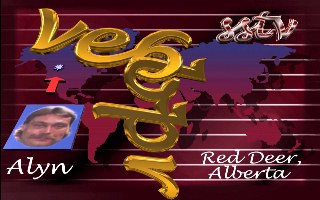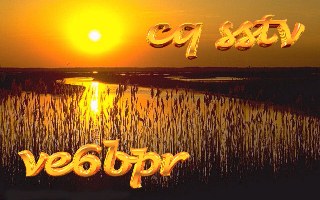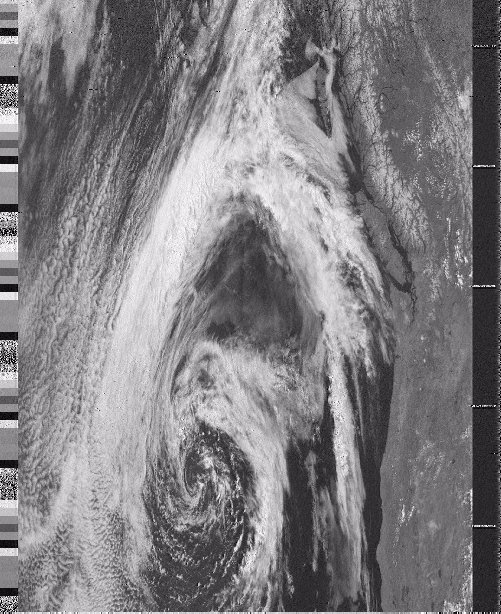

![]()
![]()
![]()
Low power (QRP) Slow Scan Television, SSTV, is another mode that
I enjoy using. This mode allows an amateur to send and receive
video pictures worldwide via 2 way radio on the HF ham bands. The
video quality of the pictures can be quite impressive.
Most slow scan pictures are transmitted and received using a home computer and suitable software. The computer is then interfaced to the radio equipment. The picture is transmitted as a series of tones and is received and displayed on the computer screen on the other end. Software for SSTV is abundant and can be found as "Freeware" or "Shareware", so you don't have to spend a lot of money to become involved with this mode.
The SSTV modes Martin 1 and Scottie 1 are the most commonly used modes.
SSTV Transmission Modes
Mode Mode Color Time Scan Family Name Type (sec) Lines Notes ------ ---- ---- ----- ----- ----- AVT 24 RBG 24 120 d 90 RGB 90 240 d 94 RGB 94 200 d 188 RGB 188 400 d 125 BW 125 400 d Martin M1 RGB 114 240 b M2 RGB 58 240 b M3 RGB 57 120 c M4 RGB 29 120 c HQ1 YC 90 240 HQ2 YC 112 240 Pasokon TV P3 RGB 203 16+480 High P5 RGB 305 16+480 Resolution P7 RGB 406 16+480 PD PD 240 YC 248 480 PD 180 YC 187 480 PD 160 YC 161 384 PD 120 YC 126 480 PD 90 YC 90 240 Robot 8 BW 8 120 a, e 12 BW 12 120 e 24 BW 24 240 e 36 BW 36 240 e 12 YC 12 120 24 YC 24 120 36 YC 36 240 72 YC 72 240 Scottie S1 RGB 110 240 b S2 RGB 71 240 b S3 RGB 55 120 c S4 RGB 36 120 c DX RGB 269 240 b Wraase SC-1 24 RGB 24 120 c 48 RGB 48 240 b 96 RGB 96 240 b Wraase SC-2 30 RGB 30 128 60 RGB 60 256 120 RGB 120 256 180 RGB 180 256 There are also some experimental modes implemented in only one or two systems. Some are still evolving, some will be phased out. Information here might not be accurate. Whether others decide to add them remains to be seen. ProSkan J120 RGB 120 240 WinPixPro GVA 125 BW 125 480 GVA 125 RGB 125 240 GVA 250 RGB 250 480 "J.A." ? ? ? 480 MSCAN TV1 ? ? ? TV2 ? ? ? Color Type: RGB - Red, Green, and Blue components sent separately. YC - Sent as Luminance (Y) and Chrominance (R-Y and B-Y). BW - Black and White. Notes: a - Similar to original 8 second black & white standard. b - Top 16 lines are gray scale. 240 usable lines. c - Top 8 lines are gray scale. 120 usable lines. d - AVT modes have a 5 second digital header and no horizontal sync. e - Robot 1200C doesn't really have B&W mode but it can send red, green, or blue memory separately. Traditionally, just the green component is sent for a rough approximation of a B&W image. (Courtesy John Langner)
HF SSTV Frequencies
3.845 MHz
3.857 MHz
7.171 MHz
14.230 MHz
14.233 MHz
21.340 MHz
28.680 MHz
Software is available for DOS as well as Windows. Some of the programs available use a simple RS-232 interface to interface the computer to the radio. Other programs can use a computer's sound card. I use a homebrew RS-232 Interface myself. I have made up my own design for a printed circuit board layout, as well as a parts list and parts placement diagram for a popular RS-232 interface called a HAMCOMM modem. This modem is compatible with several different computer programs.
*Note This circuit board layout is to be used for non-profit amateur radio use only!
The schematic for this modem can be found by downloading a DOS program called "Hamcomm", a CW, RTTY and AMTOR program and installing it on your computer.The schematic is located in the manual documentation.
My favorite SSTV program is a DOS program called "Pasokon Lite". There is also a "Freeware" version of this program called "EZSSTV". It is well worth paying the small fee to obtain the full functioning version of this software. It has a lot of nice features.

![]()


Have a look at the links below!
![]()
Slow Scan Links
Try Listening To Some.....
Weather Fax (Wefax) Satellite Image Frequencies
NOAA-14
transmits APT on 137.620 MHz
NOAA-12 and 15 transmit APT on 137.500 MHz
NOAAs transmit beacon data on 137.85 MHz when in sunlight
RESURS-O (1-4) transmits APT on 137.300 MHz
OKEAN-4 and SICH-1 sometimes transmit briefly on 137.400 MHz
GOES-E and GOES-W use 1691.0 MHz for WEFAX
For the reception of WEFAX pictures I use a Windows computer program called WXSat. This is a FREEWARE program that decodes the weather pictures using your computer's sound card. Audio from the receiver is fed into the line input of the sound card. I use a 14 element cross-yagi antenna with a modified Systcoms radio.
Below
are a couple of images received from the NOAA weather satellites.
These images are just a small portion of a continuous
"strip" of data sent.

Image received using WXSat WEFAX Software and modified Systcoms radio.

This image also received using WXSat WEFAX Software and modified Systcoms radio.
Click for HF-Fax Frequencies
